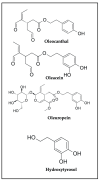Oleocanthal as a Multifunctional Anti-Cancer Agent: Mechanistic Insights, Advanced Delivery Strategies, and Synergies for Precision Oncology
- PMID: 40564985
- PMCID: PMC12193433
- DOI: 10.3390/ijms26125521
Oleocanthal as a Multifunctional Anti-Cancer Agent: Mechanistic Insights, Advanced Delivery Strategies, and Synergies for Precision Oncology
Abstract
Oleocanthal (OC), a secoiridoid phenolic compound exclusive to extra virgin olive oil (EVOO), has emerged as a promising nutraceutical with multifaceted anti-cancer properties. Despite its well-characterized anti-inflammatory and antioxidant effects, the mechanistic breadth and translational potential of OC in oncology remain underexplored and fragmented across the literature. This comprehensive review synthesizes and critically analyzes recent advances in the molecular, pharmacological, and translational landscape of OC's anti-cancer activities, providing an integrative framework to bridge preclinical evidence with future clinical application. We delineate the pleiotropic mechanisms by which OC modulates cancer hallmarks, including lysosomal membrane permeabilization (LMP)-mediated apoptosis, the inhibition of key oncogenic signaling pathways (c-MET/STAT3, PAR-2/TNF-α, COX-2/mPGES-1), the suppression of epithelial-to-mesenchymal transition (EMT), angiogenesis, and metabolic reprogramming. Furthermore, this review uniquely highlights the emerging role of OC in modulating drug resistance mechanisms by downregulating efflux transporters and sensitizing tumors to chemotherapy, targeted therapies, and immunotherapies. We also examine OC's bidirectional interaction with gut microbiota, underscoring its systemic immunometabolic effects. A major unmet need addressed by this review is the lack of consolidated knowledge regarding OC's pharmacokinetic limitations and drug-drug interaction potential in the context of polypharmacy in oncology. We provide an in-depth analysis of OC's poor bioavailability, extensive first-pass metabolism, and pharmacogenomic interactions, and systematically compile preclinical evidence on advanced delivery platforms-including nanocarriers, microneedle systems, and peptide-drug conjugates-designed to overcome these barriers. By critically evaluating the mechanistic, pharmacological, and translational dimensions of OC, this review advances the field beyond isolated mechanistic studies and offers a strategic blueprint for its integration into precision oncology. It also identifies key research gaps and outlines the future directions necessary to transition OC from a nutraceutical of dietary interest to a viable adjunctive therapeutic agent in cancer treatment.
Keywords: Mediterranean diet; cancer metabolism; gut microbiome; lysosomal membrane permeabilization; nanoparticle drug delivery; oleocanthal; polyphenols; precision oncology.
Conflict of interest statement
The authors declare that they have no competing financial interests or personal relationships which could have influenced the work reported in this paper.
Figures





Similar articles
-
Alzheimer's Disease May Benefit from Olive Oil Polyphenols: A Systematic Review on Preclinical Evidence Supporting the Effect of Oleocanthal on Amyloid-β Load.Curr Neuropharmacol. 2025;23(10):1249-1259. doi: 10.2174/011570159X327650241021115228. Curr Neuropharmacol. 2025. PMID: 39482909 Free PMC article.
-
A rare olive compound oleacein functions as a TrkB agonist and mitigates neuroinflammation both in vitro and in vivo.Cell Commun Signal. 2024 Jun 4;22(1):309. doi: 10.1186/s12964-024-01691-x. Cell Commun Signal. 2024. PMID: 38835076 Free PMC article.
-
Systemic pharmacological treatments for chronic plaque psoriasis: a network meta-analysis.Cochrane Database Syst Rev. 2021 Apr 19;4(4):CD011535. doi: 10.1002/14651858.CD011535.pub4. Cochrane Database Syst Rev. 2021. Update in: Cochrane Database Syst Rev. 2022 May 23;5:CD011535. doi: 10.1002/14651858.CD011535.pub5. PMID: 33871055 Free PMC article. Updated.
-
Systemic pharmacological treatments for chronic plaque psoriasis: a network meta-analysis.Cochrane Database Syst Rev. 2017 Dec 22;12(12):CD011535. doi: 10.1002/14651858.CD011535.pub2. Cochrane Database Syst Rev. 2017. Update in: Cochrane Database Syst Rev. 2020 Jan 9;1:CD011535. doi: 10.1002/14651858.CD011535.pub3. PMID: 29271481 Free PMC article. Updated.
-
A rapid and systematic review of the clinical effectiveness and cost-effectiveness of paclitaxel, docetaxel, gemcitabine and vinorelbine in non-small-cell lung cancer.Health Technol Assess. 2001;5(32):1-195. doi: 10.3310/hta5320. Health Technol Assess. 2001. PMID: 12065068
Cited by
-
Exploring Experimental Models of Colorectal Cancer: A Critical Appraisal from 2D Cell Systems to Organoids, Humanized Mouse Avatars, Organ-on-Chip, CRISPR Engineering, and AI-Driven Platforms-Challenges and Opportunities for Translational Precision Oncology.Cancers (Basel). 2025 Jun 26;17(13):2163. doi: 10.3390/cancers17132163. Cancers (Basel). 2025. PMID: 40647462 Free PMC article. Review.
-
Harnessing Nature's Chemistry: Deciphering Olive Oil Phenolics for the Control of Invasive Breast Carcinoma.Molecules. 2025 Jul 28;30(15):3157. doi: 10.3390/molecules30153157. Molecules. 2025. PMID: 40807332 Free PMC article.
References
Publication types
MeSH terms
Substances
LinkOut - more resources
Full Text Sources
Medical
Research Materials
Miscellaneous

